Psychosocial Factors in Hypertension: Development, Progression, Essay
VerifiedAdded on 2022/10/15
|11
|3113
|11
Essay
AI Summary
This essay delves into the multifaceted nature of hypertension, examining its development, progression, prevention, treatment, and impacts through a biopsychosocial lens. It explores the intricate interplay of biological factors such as age, gender, and genetics, with psychological elements like stress, goal-striving, and emotional states, alongside social determinants including discrimination, unemployment, and social cohesion. The essay highlights the significance of lifestyle choices, including diet, exercise, and substance use, while also considering barriers to behavior change and the role of healthcare services in risk management and treatment. Furthermore, it discusses the application of psychological principles, such as stimulation, socialization, identity, and control, to facilitate optimal coping and enhance quality of life for individuals affected by hypertension. The student also reflects on personal engagement with healthcare services and the importance of education and awareness in managing hypertension risks.
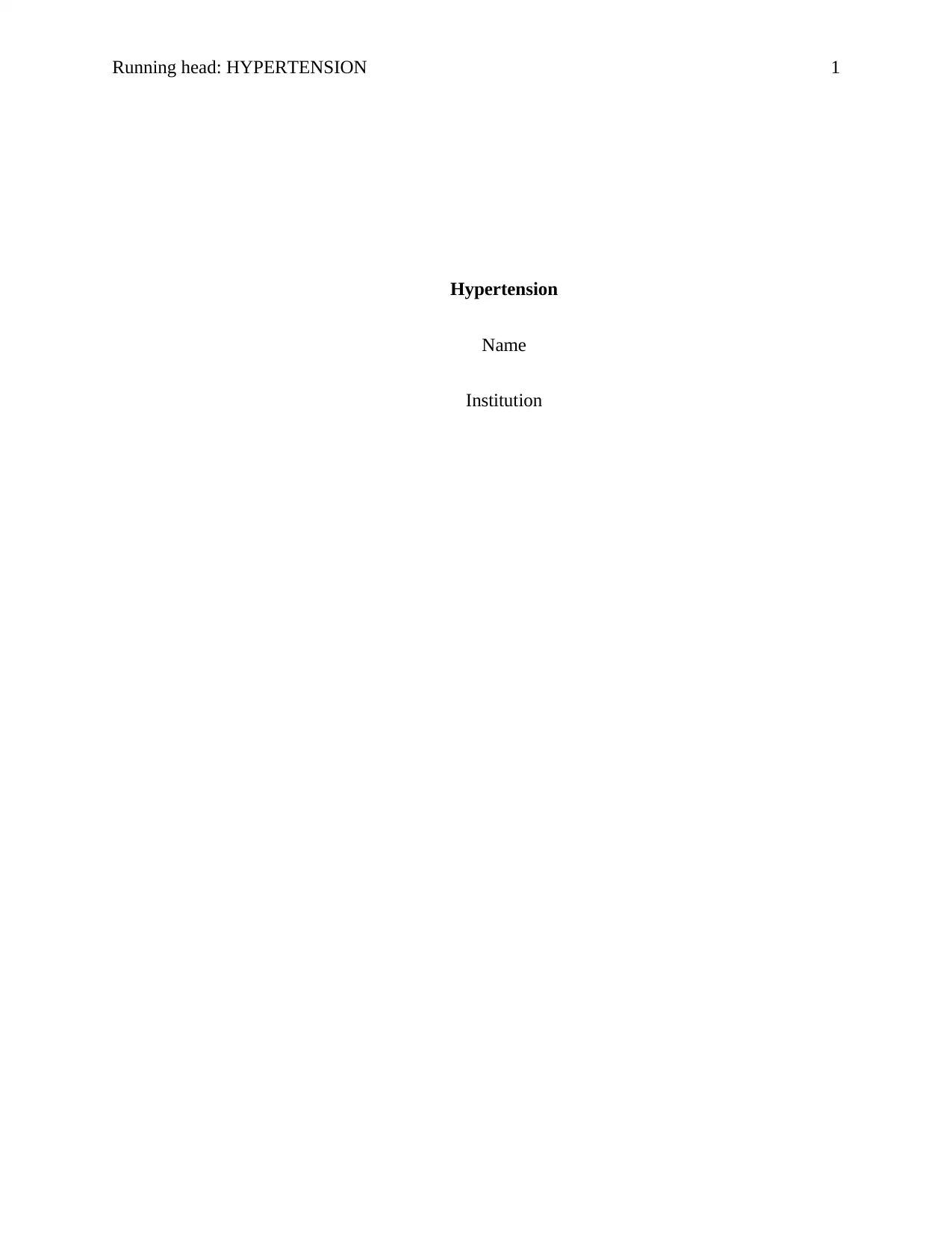
Running head: HYPERTENSION 1
Hypertension
Name
Institution
Hypertension
Name
Institution
Paraphrase This Document
Need a fresh take? Get an instant paraphrase of this document with our AI Paraphraser
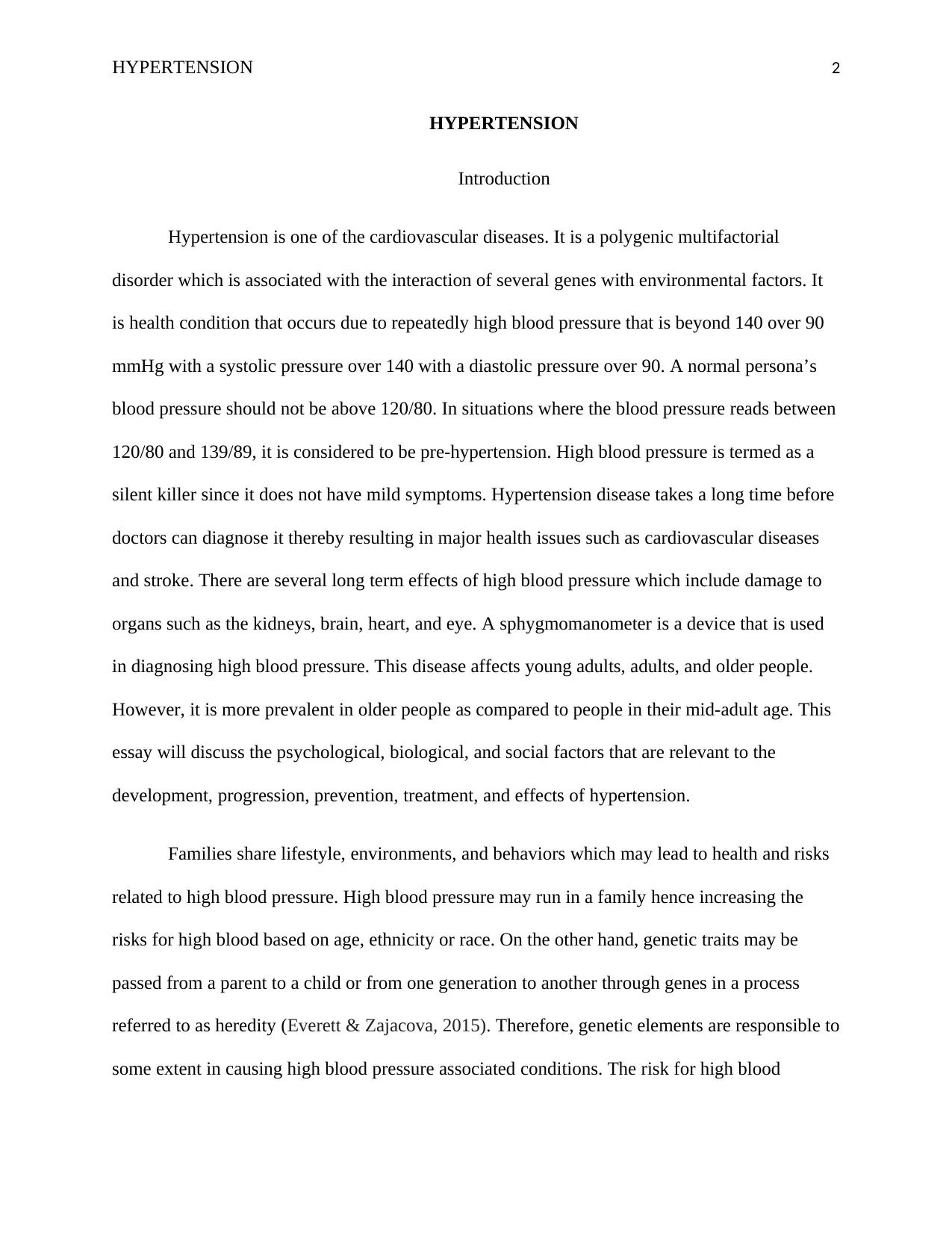
HYPERTENSION 2
HYPERTENSION
Introduction
Hypertension is one of the cardiovascular diseases. It is a polygenic multifactorial
disorder which is associated with the interaction of several genes with environmental factors. It
is health condition that occurs due to repeatedly high blood pressure that is beyond 140 over 90
mmHg with a systolic pressure over 140 with a diastolic pressure over 90. A normal persona’s
blood pressure should not be above 120/80. In situations where the blood pressure reads between
120/80 and 139/89, it is considered to be pre-hypertension. High blood pressure is termed as a
silent killer since it does not have mild symptoms. Hypertension disease takes a long time before
doctors can diagnose it thereby resulting in major health issues such as cardiovascular diseases
and stroke. There are several long term effects of high blood pressure which include damage to
organs such as the kidneys, brain, heart, and eye. A sphygmomanometer is a device that is used
in diagnosing high blood pressure. This disease affects young adults, adults, and older people.
However, it is more prevalent in older people as compared to people in their mid-adult age. This
essay will discuss the psychological, biological, and social factors that are relevant to the
development, progression, prevention, treatment, and effects of hypertension.
Families share lifestyle, environments, and behaviors which may lead to health and risks
related to high blood pressure. High blood pressure may run in a family hence increasing the
risks for high blood based on age, ethnicity or race. On the other hand, genetic traits may be
passed from a parent to a child or from one generation to another through genes in a process
referred to as heredity (Everett & Zajacova, 2015). Therefore, genetic elements are responsible to
some extent in causing high blood pressure associated conditions. The risk for high blood
HYPERTENSION
Introduction
Hypertension is one of the cardiovascular diseases. It is a polygenic multifactorial
disorder which is associated with the interaction of several genes with environmental factors. It
is health condition that occurs due to repeatedly high blood pressure that is beyond 140 over 90
mmHg with a systolic pressure over 140 with a diastolic pressure over 90. A normal persona’s
blood pressure should not be above 120/80. In situations where the blood pressure reads between
120/80 and 139/89, it is considered to be pre-hypertension. High blood pressure is termed as a
silent killer since it does not have mild symptoms. Hypertension disease takes a long time before
doctors can diagnose it thereby resulting in major health issues such as cardiovascular diseases
and stroke. There are several long term effects of high blood pressure which include damage to
organs such as the kidneys, brain, heart, and eye. A sphygmomanometer is a device that is used
in diagnosing high blood pressure. This disease affects young adults, adults, and older people.
However, it is more prevalent in older people as compared to people in their mid-adult age. This
essay will discuss the psychological, biological, and social factors that are relevant to the
development, progression, prevention, treatment, and effects of hypertension.
Families share lifestyle, environments, and behaviors which may lead to health and risks
related to high blood pressure. High blood pressure may run in a family hence increasing the
risks for high blood based on age, ethnicity or race. On the other hand, genetic traits may be
passed from a parent to a child or from one generation to another through genes in a process
referred to as heredity (Everett & Zajacova, 2015). Therefore, genetic elements are responsible to
some extent in causing high blood pressure associated conditions. The risk for high blood
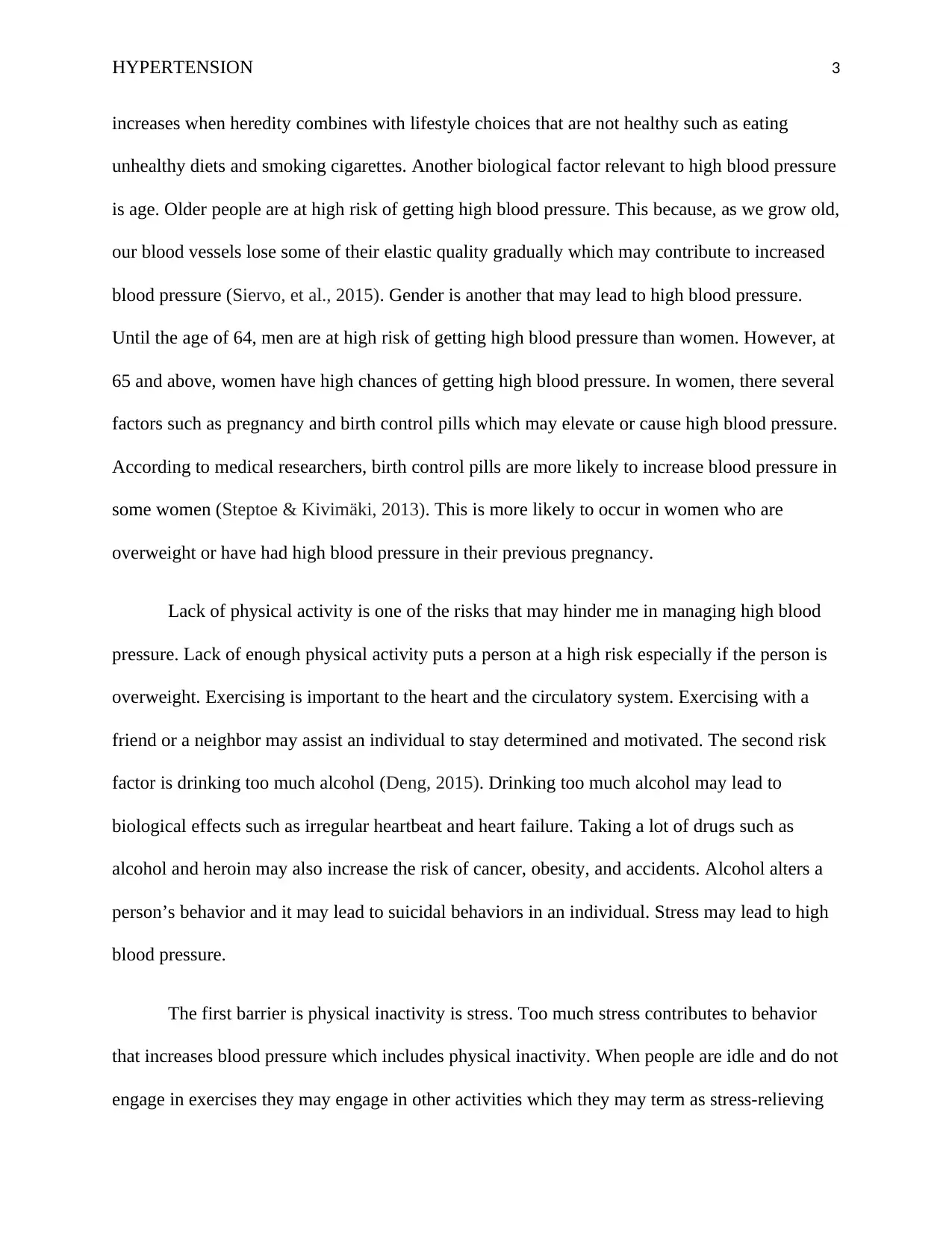
HYPERTENSION 3
increases when heredity combines with lifestyle choices that are not healthy such as eating
unhealthy diets and smoking cigarettes. Another biological factor relevant to high blood pressure
is age. Older people are at high risk of getting high blood pressure. This because, as we grow old,
our blood vessels lose some of their elastic quality gradually which may contribute to increased
blood pressure (Siervo, et al., 2015). Gender is another that may lead to high blood pressure.
Until the age of 64, men are at high risk of getting high blood pressure than women. However, at
65 and above, women have high chances of getting high blood pressure. In women, there several
factors such as pregnancy and birth control pills which may elevate or cause high blood pressure.
According to medical researchers, birth control pills are more likely to increase blood pressure in
some women (Steptoe & Kivimäki, 2013). This is more likely to occur in women who are
overweight or have had high blood pressure in their previous pregnancy.
Lack of physical activity is one of the risks that may hinder me in managing high blood
pressure. Lack of enough physical activity puts a person at a high risk especially if the person is
overweight. Exercising is important to the heart and the circulatory system. Exercising with a
friend or a neighbor may assist an individual to stay determined and motivated. The second risk
factor is drinking too much alcohol (Deng, 2015). Drinking too much alcohol may lead to
biological effects such as irregular heartbeat and heart failure. Taking a lot of drugs such as
alcohol and heroin may also increase the risk of cancer, obesity, and accidents. Alcohol alters a
person’s behavior and it may lead to suicidal behaviors in an individual. Stress may lead to high
blood pressure.
The first barrier is physical inactivity is stress. Too much stress contributes to behavior
that increases blood pressure which includes physical inactivity. When people are idle and do not
engage in exercises they may engage in other activities which they may term as stress-relieving
increases when heredity combines with lifestyle choices that are not healthy such as eating
unhealthy diets and smoking cigarettes. Another biological factor relevant to high blood pressure
is age. Older people are at high risk of getting high blood pressure. This because, as we grow old,
our blood vessels lose some of their elastic quality gradually which may contribute to increased
blood pressure (Siervo, et al., 2015). Gender is another that may lead to high blood pressure.
Until the age of 64, men are at high risk of getting high blood pressure than women. However, at
65 and above, women have high chances of getting high blood pressure. In women, there several
factors such as pregnancy and birth control pills which may elevate or cause high blood pressure.
According to medical researchers, birth control pills are more likely to increase blood pressure in
some women (Steptoe & Kivimäki, 2013). This is more likely to occur in women who are
overweight or have had high blood pressure in their previous pregnancy.
Lack of physical activity is one of the risks that may hinder me in managing high blood
pressure. Lack of enough physical activity puts a person at a high risk especially if the person is
overweight. Exercising is important to the heart and the circulatory system. Exercising with a
friend or a neighbor may assist an individual to stay determined and motivated. The second risk
factor is drinking too much alcohol (Deng, 2015). Drinking too much alcohol may lead to
biological effects such as irregular heartbeat and heart failure. Taking a lot of drugs such as
alcohol and heroin may also increase the risk of cancer, obesity, and accidents. Alcohol alters a
person’s behavior and it may lead to suicidal behaviors in an individual. Stress may lead to high
blood pressure.
The first barrier is physical inactivity is stress. Too much stress contributes to behavior
that increases blood pressure which includes physical inactivity. When people are idle and do not
engage in exercises they may engage in other activities which they may term as stress-relieving
⊘ This is a preview!⊘
Do you want full access?
Subscribe today to unlock all pages.

Trusted by 1+ million students worldwide
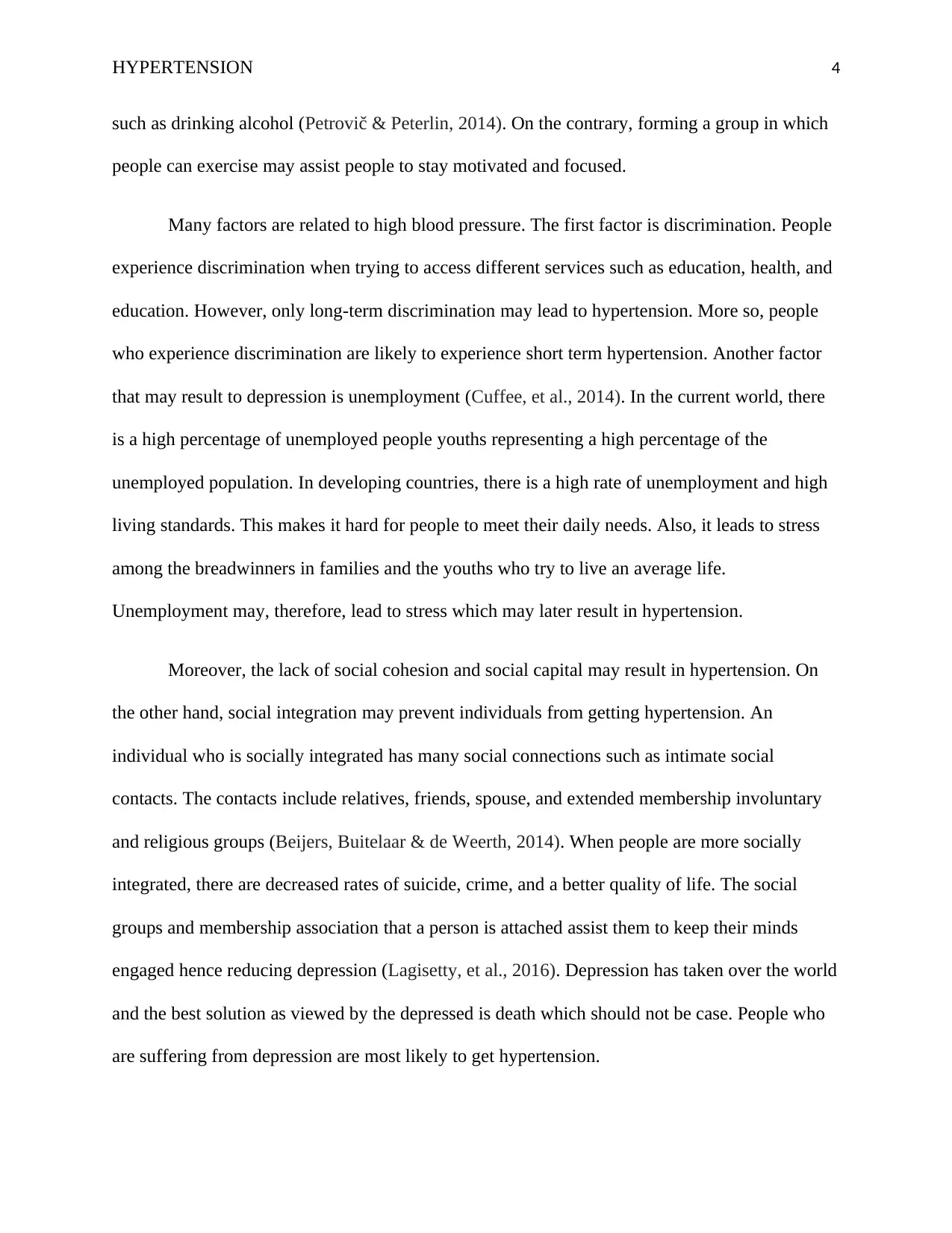
HYPERTENSION 4
such as drinking alcohol (Petrovič & Peterlin, 2014). On the contrary, forming a group in which
people can exercise may assist people to stay motivated and focused.
Many factors are related to high blood pressure. The first factor is discrimination. People
experience discrimination when trying to access different services such as education, health, and
education. However, only long-term discrimination may lead to hypertension. More so, people
who experience discrimination are likely to experience short term hypertension. Another factor
that may result to depression is unemployment (Cuffee, et al., 2014). In the current world, there
is a high percentage of unemployed people youths representing a high percentage of the
unemployed population. In developing countries, there is a high rate of unemployment and high
living standards. This makes it hard for people to meet their daily needs. Also, it leads to stress
among the breadwinners in families and the youths who try to live an average life.
Unemployment may, therefore, lead to stress which may later result in hypertension.
Moreover, the lack of social cohesion and social capital may result in hypertension. On
the other hand, social integration may prevent individuals from getting hypertension. An
individual who is socially integrated has many social connections such as intimate social
contacts. The contacts include relatives, friends, spouse, and extended membership involuntary
and religious groups (Beijers, Buitelaar & de Weerth, 2014). When people are more socially
integrated, there are decreased rates of suicide, crime, and a better quality of life. The social
groups and membership association that a person is attached assist them to keep their minds
engaged hence reducing depression (Lagisetty, et al., 2016). Depression has taken over the world
and the best solution as viewed by the depressed is death which should not be case. People who
are suffering from depression are most likely to get hypertension.
such as drinking alcohol (Petrovič & Peterlin, 2014). On the contrary, forming a group in which
people can exercise may assist people to stay motivated and focused.
Many factors are related to high blood pressure. The first factor is discrimination. People
experience discrimination when trying to access different services such as education, health, and
education. However, only long-term discrimination may lead to hypertension. More so, people
who experience discrimination are likely to experience short term hypertension. Another factor
that may result to depression is unemployment (Cuffee, et al., 2014). In the current world, there
is a high percentage of unemployed people youths representing a high percentage of the
unemployed population. In developing countries, there is a high rate of unemployment and high
living standards. This makes it hard for people to meet their daily needs. Also, it leads to stress
among the breadwinners in families and the youths who try to live an average life.
Unemployment may, therefore, lead to stress which may later result in hypertension.
Moreover, the lack of social cohesion and social capital may result in hypertension. On
the other hand, social integration may prevent individuals from getting hypertension. An
individual who is socially integrated has many social connections such as intimate social
contacts. The contacts include relatives, friends, spouse, and extended membership involuntary
and religious groups (Beijers, Buitelaar & de Weerth, 2014). When people are more socially
integrated, there are decreased rates of suicide, crime, and a better quality of life. The social
groups and membership association that a person is attached assist them to keep their minds
engaged hence reducing depression (Lagisetty, et al., 2016). Depression has taken over the world
and the best solution as viewed by the depressed is death which should not be case. People who
are suffering from depression are most likely to get hypertension.
Paraphrase This Document
Need a fresh take? Get an instant paraphrase of this document with our AI Paraphraser
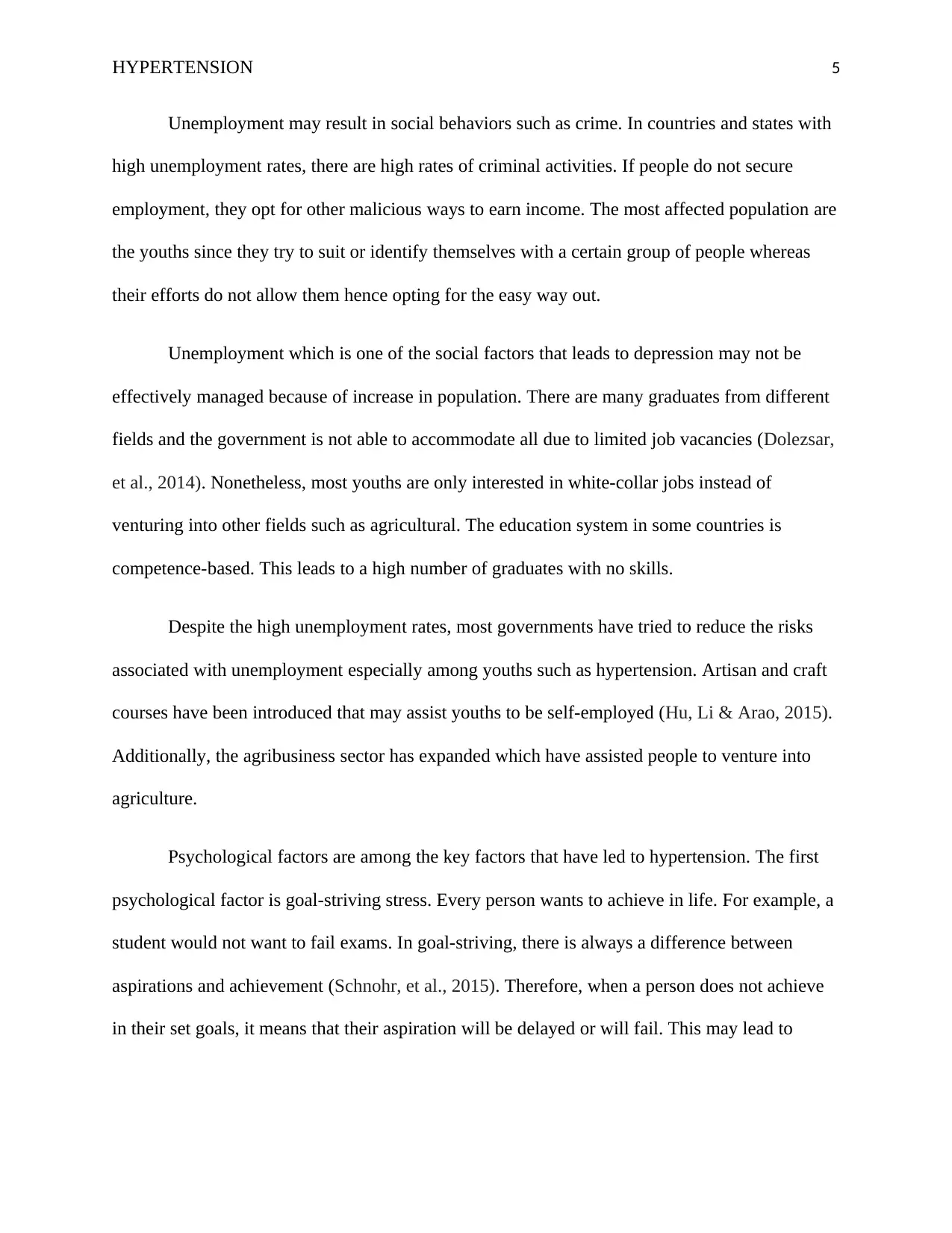
HYPERTENSION 5
Unemployment may result in social behaviors such as crime. In countries and states with
high unemployment rates, there are high rates of criminal activities. If people do not secure
employment, they opt for other malicious ways to earn income. The most affected population are
the youths since they try to suit or identify themselves with a certain group of people whereas
their efforts do not allow them hence opting for the easy way out.
Unemployment which is one of the social factors that leads to depression may not be
effectively managed because of increase in population. There are many graduates from different
fields and the government is not able to accommodate all due to limited job vacancies (Dolezsar,
et al., 2014). Nonetheless, most youths are only interested in white-collar jobs instead of
venturing into other fields such as agricultural. The education system in some countries is
competence-based. This leads to a high number of graduates with no skills.
Despite the high unemployment rates, most governments have tried to reduce the risks
associated with unemployment especially among youths such as hypertension. Artisan and craft
courses have been introduced that may assist youths to be self-employed (Hu, Li & Arao, 2015).
Additionally, the agribusiness sector has expanded which have assisted people to venture into
agriculture.
Psychological factors are among the key factors that have led to hypertension. The first
psychological factor is goal-striving stress. Every person wants to achieve in life. For example, a
student would not want to fail exams. In goal-striving, there is always a difference between
aspirations and achievement (Schnohr, et al., 2015). Therefore, when a person does not achieve
in their set goals, it means that their aspiration will be delayed or will fail. This may lead to
Unemployment may result in social behaviors such as crime. In countries and states with
high unemployment rates, there are high rates of criminal activities. If people do not secure
employment, they opt for other malicious ways to earn income. The most affected population are
the youths since they try to suit or identify themselves with a certain group of people whereas
their efforts do not allow them hence opting for the easy way out.
Unemployment which is one of the social factors that leads to depression may not be
effectively managed because of increase in population. There are many graduates from different
fields and the government is not able to accommodate all due to limited job vacancies (Dolezsar,
et al., 2014). Nonetheless, most youths are only interested in white-collar jobs instead of
venturing into other fields such as agricultural. The education system in some countries is
competence-based. This leads to a high number of graduates with no skills.
Despite the high unemployment rates, most governments have tried to reduce the risks
associated with unemployment especially among youths such as hypertension. Artisan and craft
courses have been introduced that may assist youths to be self-employed (Hu, Li & Arao, 2015).
Additionally, the agribusiness sector has expanded which have assisted people to venture into
agriculture.
Psychological factors are among the key factors that have led to hypertension. The first
psychological factor is goal-striving stress. Every person wants to achieve in life. For example, a
student would not want to fail exams. In goal-striving, there is always a difference between
aspirations and achievement (Schnohr, et al., 2015). Therefore, when a person does not achieve
in their set goals, it means that their aspiration will be delayed or will fail. This may lead to
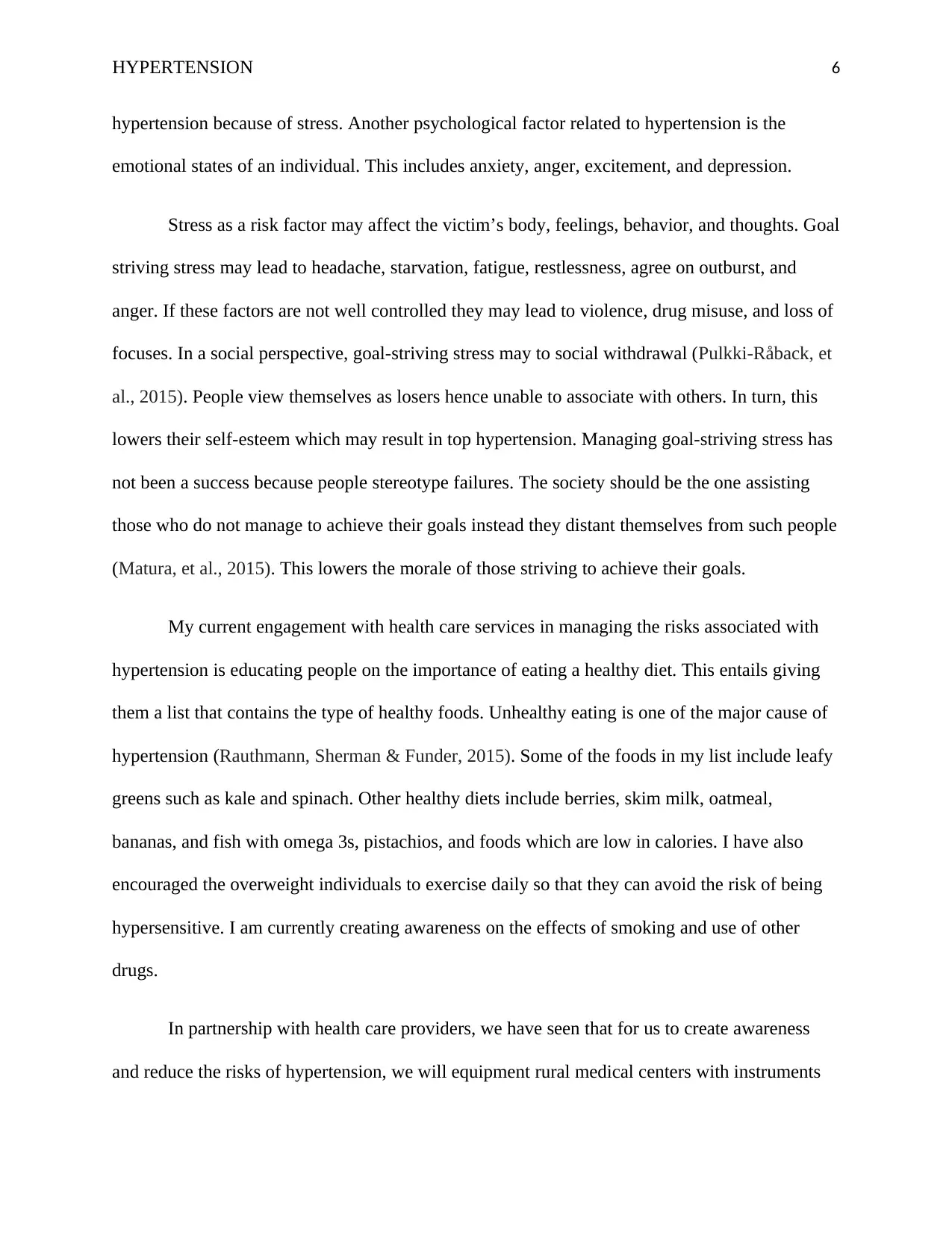
HYPERTENSION 6
hypertension because of stress. Another psychological factor related to hypertension is the
emotional states of an individual. This includes anxiety, anger, excitement, and depression.
Stress as a risk factor may affect the victim’s body, feelings, behavior, and thoughts. Goal
striving stress may lead to headache, starvation, fatigue, restlessness, agree on outburst, and
anger. If these factors are not well controlled they may lead to violence, drug misuse, and loss of
focuses. In a social perspective, goal-striving stress may to social withdrawal (Pulkki-Råback, et
al., 2015). People view themselves as losers hence unable to associate with others. In turn, this
lowers their self-esteem which may result in top hypertension. Managing goal-striving stress has
not been a success because people stereotype failures. The society should be the one assisting
those who do not manage to achieve their goals instead they distant themselves from such people
(Matura, et al., 2015). This lowers the morale of those striving to achieve their goals.
My current engagement with health care services in managing the risks associated with
hypertension is educating people on the importance of eating a healthy diet. This entails giving
them a list that contains the type of healthy foods. Unhealthy eating is one of the major cause of
hypertension (Rauthmann, Sherman & Funder, 2015). Some of the foods in my list include leafy
greens such as kale and spinach. Other healthy diets include berries, skim milk, oatmeal,
bananas, and fish with omega 3s, pistachios, and foods which are low in calories. I have also
encouraged the overweight individuals to exercise daily so that they can avoid the risk of being
hypersensitive. I am currently creating awareness on the effects of smoking and use of other
drugs.
In partnership with health care providers, we have seen that for us to create awareness
and reduce the risks of hypertension, we will equipment rural medical centers with instruments
hypertension because of stress. Another psychological factor related to hypertension is the
emotional states of an individual. This includes anxiety, anger, excitement, and depression.
Stress as a risk factor may affect the victim’s body, feelings, behavior, and thoughts. Goal
striving stress may lead to headache, starvation, fatigue, restlessness, agree on outburst, and
anger. If these factors are not well controlled they may lead to violence, drug misuse, and loss of
focuses. In a social perspective, goal-striving stress may to social withdrawal (Pulkki-Råback, et
al., 2015). People view themselves as losers hence unable to associate with others. In turn, this
lowers their self-esteem which may result in top hypertension. Managing goal-striving stress has
not been a success because people stereotype failures. The society should be the one assisting
those who do not manage to achieve their goals instead they distant themselves from such people
(Matura, et al., 2015). This lowers the morale of those striving to achieve their goals.
My current engagement with health care services in managing the risks associated with
hypertension is educating people on the importance of eating a healthy diet. This entails giving
them a list that contains the type of healthy foods. Unhealthy eating is one of the major cause of
hypertension (Rauthmann, Sherman & Funder, 2015). Some of the foods in my list include leafy
greens such as kale and spinach. Other healthy diets include berries, skim milk, oatmeal,
bananas, and fish with omega 3s, pistachios, and foods which are low in calories. I have also
encouraged the overweight individuals to exercise daily so that they can avoid the risk of being
hypersensitive. I am currently creating awareness on the effects of smoking and use of other
drugs.
In partnership with health care providers, we have seen that for us to create awareness
and reduce the risks of hypertension, we will equipment rural medical centers with instruments
⊘ This is a preview!⊘
Do you want full access?
Subscribe today to unlock all pages.

Trusted by 1+ million students worldwide
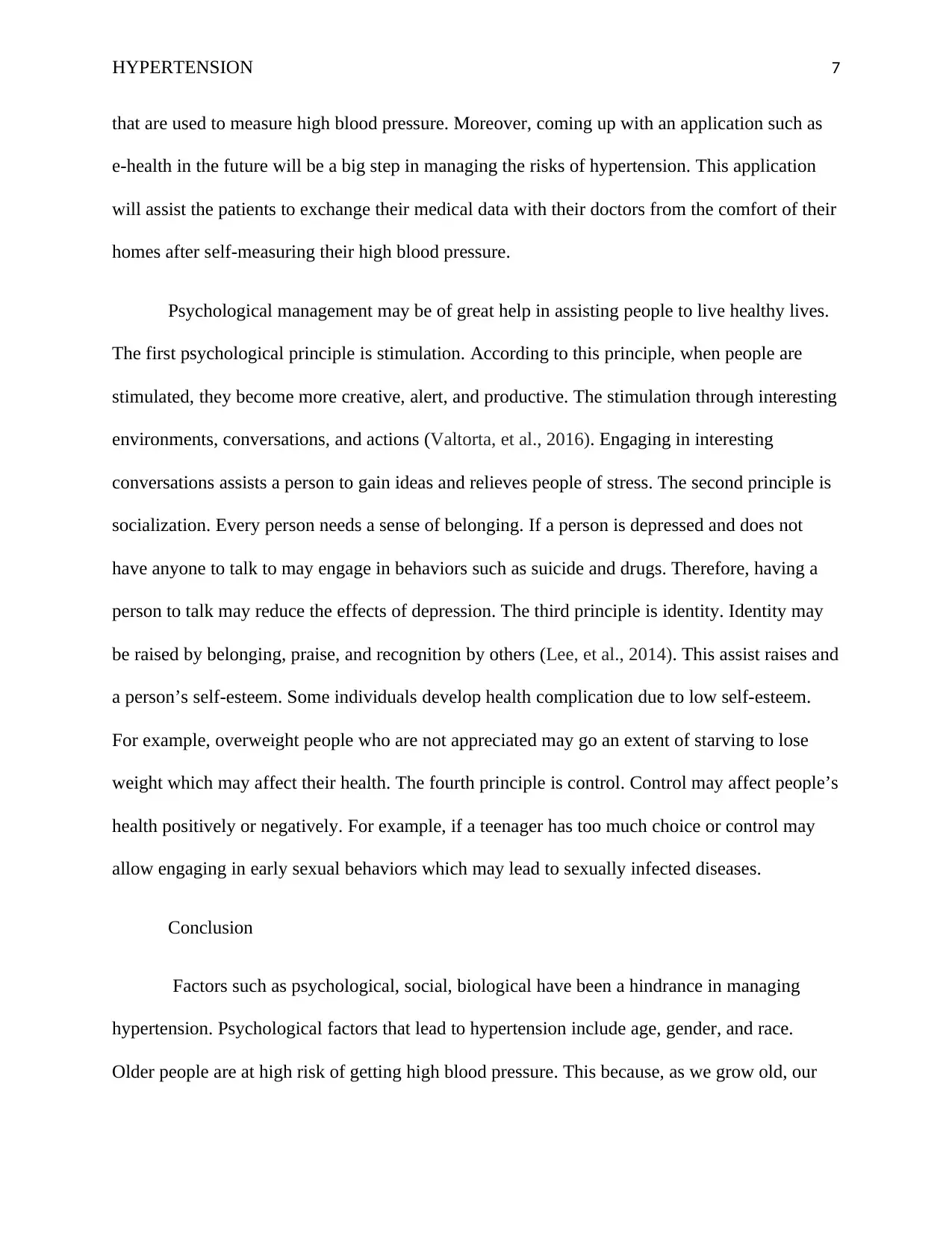
HYPERTENSION 7
that are used to measure high blood pressure. Moreover, coming up with an application such as
e-health in the future will be a big step in managing the risks of hypertension. This application
will assist the patients to exchange their medical data with their doctors from the comfort of their
homes after self-measuring their high blood pressure.
Psychological management may be of great help in assisting people to live healthy lives.
The first psychological principle is stimulation. According to this principle, when people are
stimulated, they become more creative, alert, and productive. The stimulation through interesting
environments, conversations, and actions (Valtorta, et al., 2016). Engaging in interesting
conversations assists a person to gain ideas and relieves people of stress. The second principle is
socialization. Every person needs a sense of belonging. If a person is depressed and does not
have anyone to talk to may engage in behaviors such as suicide and drugs. Therefore, having a
person to talk may reduce the effects of depression. The third principle is identity. Identity may
be raised by belonging, praise, and recognition by others (Lee, et al., 2014). This assist raises and
a person’s self-esteem. Some individuals develop health complication due to low self-esteem.
For example, overweight people who are not appreciated may go an extent of starving to lose
weight which may affect their health. The fourth principle is control. Control may affect people’s
health positively or negatively. For example, if a teenager has too much choice or control may
allow engaging in early sexual behaviors which may lead to sexually infected diseases.
Conclusion
Factors such as psychological, social, biological have been a hindrance in managing
hypertension. Psychological factors that lead to hypertension include age, gender, and race.
Older people are at high risk of getting high blood pressure. This because, as we grow old, our
that are used to measure high blood pressure. Moreover, coming up with an application such as
e-health in the future will be a big step in managing the risks of hypertension. This application
will assist the patients to exchange their medical data with their doctors from the comfort of their
homes after self-measuring their high blood pressure.
Psychological management may be of great help in assisting people to live healthy lives.
The first psychological principle is stimulation. According to this principle, when people are
stimulated, they become more creative, alert, and productive. The stimulation through interesting
environments, conversations, and actions (Valtorta, et al., 2016). Engaging in interesting
conversations assists a person to gain ideas and relieves people of stress. The second principle is
socialization. Every person needs a sense of belonging. If a person is depressed and does not
have anyone to talk to may engage in behaviors such as suicide and drugs. Therefore, having a
person to talk may reduce the effects of depression. The third principle is identity. Identity may
be raised by belonging, praise, and recognition by others (Lee, et al., 2014). This assist raises and
a person’s self-esteem. Some individuals develop health complication due to low self-esteem.
For example, overweight people who are not appreciated may go an extent of starving to lose
weight which may affect their health. The fourth principle is control. Control may affect people’s
health positively or negatively. For example, if a teenager has too much choice or control may
allow engaging in early sexual behaviors which may lead to sexually infected diseases.
Conclusion
Factors such as psychological, social, biological have been a hindrance in managing
hypertension. Psychological factors that lead to hypertension include age, gender, and race.
Older people are at high risk of getting high blood pressure. This because, as we grow old, our
Paraphrase This Document
Need a fresh take? Get an instant paraphrase of this document with our AI Paraphraser
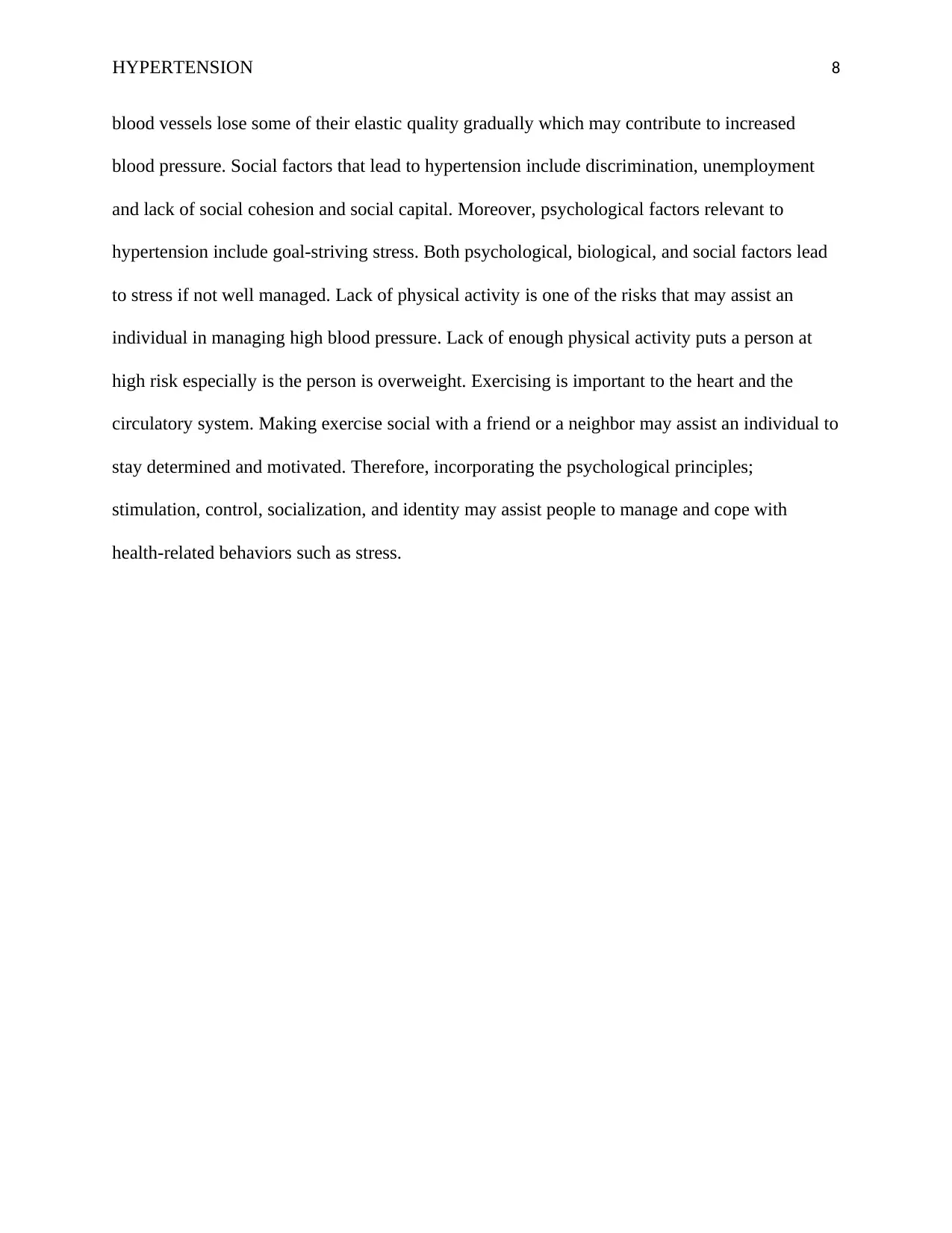
HYPERTENSION 8
blood vessels lose some of their elastic quality gradually which may contribute to increased
blood pressure. Social factors that lead to hypertension include discrimination, unemployment
and lack of social cohesion and social capital. Moreover, psychological factors relevant to
hypertension include goal-striving stress. Both psychological, biological, and social factors lead
to stress if not well managed. Lack of physical activity is one of the risks that may assist an
individual in managing high blood pressure. Lack of enough physical activity puts a person at
high risk especially is the person is overweight. Exercising is important to the heart and the
circulatory system. Making exercise social with a friend or a neighbor may assist an individual to
stay determined and motivated. Therefore, incorporating the psychological principles;
stimulation, control, socialization, and identity may assist people to manage and cope with
health-related behaviors such as stress.
blood vessels lose some of their elastic quality gradually which may contribute to increased
blood pressure. Social factors that lead to hypertension include discrimination, unemployment
and lack of social cohesion and social capital. Moreover, psychological factors relevant to
hypertension include goal-striving stress. Both psychological, biological, and social factors lead
to stress if not well managed. Lack of physical activity is one of the risks that may assist an
individual in managing high blood pressure. Lack of enough physical activity puts a person at
high risk especially is the person is overweight. Exercising is important to the heart and the
circulatory system. Making exercise social with a friend or a neighbor may assist an individual to
stay determined and motivated. Therefore, incorporating the psychological principles;
stimulation, control, socialization, and identity may assist people to manage and cope with
health-related behaviors such as stress.
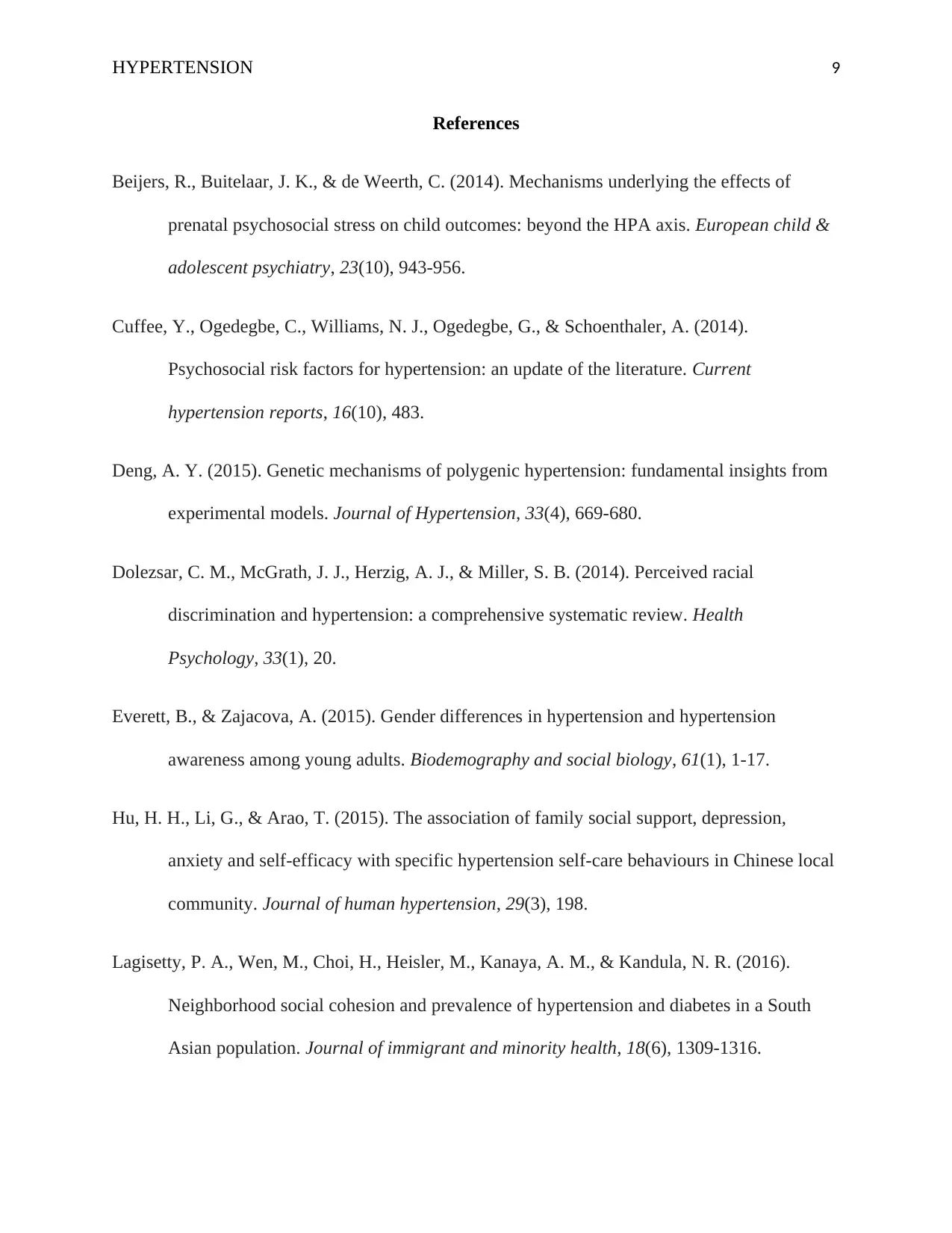
HYPERTENSION 9
References
Beijers, R., Buitelaar, J. K., & de Weerth, C. (2014). Mechanisms underlying the effects of
prenatal psychosocial stress on child outcomes: beyond the HPA axis. European child &
adolescent psychiatry, 23(10), 943-956.
Cuffee, Y., Ogedegbe, C., Williams, N. J., Ogedegbe, G., & Schoenthaler, A. (2014).
Psychosocial risk factors for hypertension: an update of the literature. Current
hypertension reports, 16(10), 483.
Deng, A. Y. (2015). Genetic mechanisms of polygenic hypertension: fundamental insights from
experimental models. Journal of Hypertension, 33(4), 669-680.
Dolezsar, C. M., McGrath, J. J., Herzig, A. J., & Miller, S. B. (2014). Perceived racial
discrimination and hypertension: a comprehensive systematic review. Health
Psychology, 33(1), 20.
Everett, B., & Zajacova, A. (2015). Gender differences in hypertension and hypertension
awareness among young adults. Biodemography and social biology, 61(1), 1-17.
Hu, H. H., Li, G., & Arao, T. (2015). The association of family social support, depression,
anxiety and self-efficacy with specific hypertension self-care behaviours in Chinese local
community. Journal of human hypertension, 29(3), 198.
Lagisetty, P. A., Wen, M., Choi, H., Heisler, M., Kanaya, A. M., & Kandula, N. R. (2016).
Neighborhood social cohesion and prevalence of hypertension and diabetes in a South
Asian population. Journal of immigrant and minority health, 18(6), 1309-1316.
References
Beijers, R., Buitelaar, J. K., & de Weerth, C. (2014). Mechanisms underlying the effects of
prenatal psychosocial stress on child outcomes: beyond the HPA axis. European child &
adolescent psychiatry, 23(10), 943-956.
Cuffee, Y., Ogedegbe, C., Williams, N. J., Ogedegbe, G., & Schoenthaler, A. (2014).
Psychosocial risk factors for hypertension: an update of the literature. Current
hypertension reports, 16(10), 483.
Deng, A. Y. (2015). Genetic mechanisms of polygenic hypertension: fundamental insights from
experimental models. Journal of Hypertension, 33(4), 669-680.
Dolezsar, C. M., McGrath, J. J., Herzig, A. J., & Miller, S. B. (2014). Perceived racial
discrimination and hypertension: a comprehensive systematic review. Health
Psychology, 33(1), 20.
Everett, B., & Zajacova, A. (2015). Gender differences in hypertension and hypertension
awareness among young adults. Biodemography and social biology, 61(1), 1-17.
Hu, H. H., Li, G., & Arao, T. (2015). The association of family social support, depression,
anxiety and self-efficacy with specific hypertension self-care behaviours in Chinese local
community. Journal of human hypertension, 29(3), 198.
Lagisetty, P. A., Wen, M., Choi, H., Heisler, M., Kanaya, A. M., & Kandula, N. R. (2016).
Neighborhood social cohesion and prevalence of hypertension and diabetes in a South
Asian population. Journal of immigrant and minority health, 18(6), 1309-1316.
⊘ This is a preview!⊘
Do you want full access?
Subscribe today to unlock all pages.

Trusted by 1+ million students worldwide
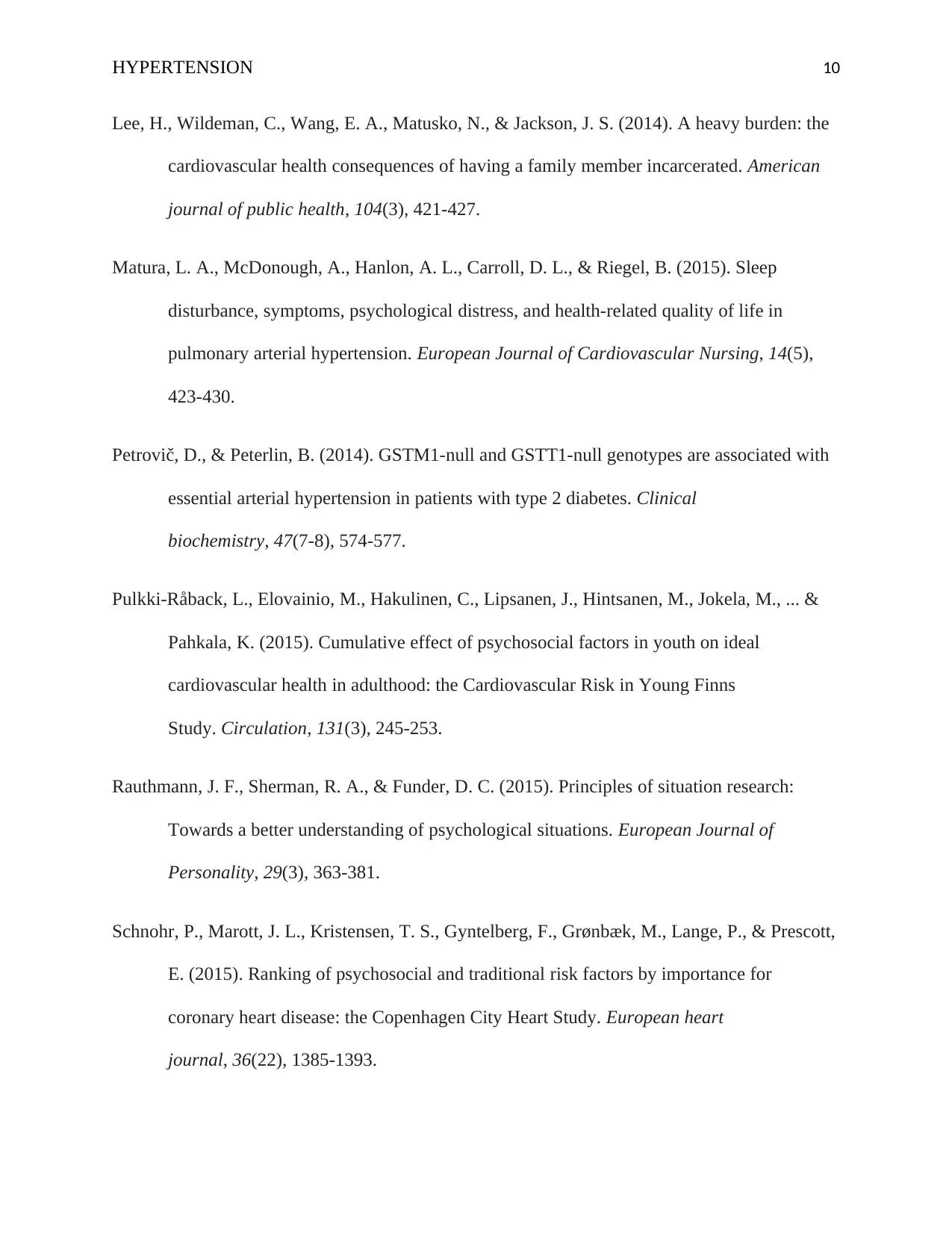
HYPERTENSION 10
Lee, H., Wildeman, C., Wang, E. A., Matusko, N., & Jackson, J. S. (2014). A heavy burden: the
cardiovascular health consequences of having a family member incarcerated. American
journal of public health, 104(3), 421-427.
Matura, L. A., McDonough, A., Hanlon, A. L., Carroll, D. L., & Riegel, B. (2015). Sleep
disturbance, symptoms, psychological distress, and health-related quality of life in
pulmonary arterial hypertension. European Journal of Cardiovascular Nursing, 14(5),
423-430.
Petrovič, D., & Peterlin, B. (2014). GSTM1-null and GSTT1-null genotypes are associated with
essential arterial hypertension in patients with type 2 diabetes. Clinical
biochemistry, 47(7-8), 574-577.
Pulkki-Råback, L., Elovainio, M., Hakulinen, C., Lipsanen, J., Hintsanen, M., Jokela, M., ... &
Pahkala, K. (2015). Cumulative effect of psychosocial factors in youth on ideal
cardiovascular health in adulthood: the Cardiovascular Risk in Young Finns
Study. Circulation, 131(3), 245-253.
Rauthmann, J. F., Sherman, R. A., & Funder, D. C. (2015). Principles of situation research:
Towards a better understanding of psychological situations. European Journal of
Personality, 29(3), 363-381.
Schnohr, P., Marott, J. L., Kristensen, T. S., Gyntelberg, F., Grønbæk, M., Lange, P., & Prescott,
E. (2015). Ranking of psychosocial and traditional risk factors by importance for
coronary heart disease: the Copenhagen City Heart Study. European heart
journal, 36(22), 1385-1393.
Lee, H., Wildeman, C., Wang, E. A., Matusko, N., & Jackson, J. S. (2014). A heavy burden: the
cardiovascular health consequences of having a family member incarcerated. American
journal of public health, 104(3), 421-427.
Matura, L. A., McDonough, A., Hanlon, A. L., Carroll, D. L., & Riegel, B. (2015). Sleep
disturbance, symptoms, psychological distress, and health-related quality of life in
pulmonary arterial hypertension. European Journal of Cardiovascular Nursing, 14(5),
423-430.
Petrovič, D., & Peterlin, B. (2014). GSTM1-null and GSTT1-null genotypes are associated with
essential arterial hypertension in patients with type 2 diabetes. Clinical
biochemistry, 47(7-8), 574-577.
Pulkki-Råback, L., Elovainio, M., Hakulinen, C., Lipsanen, J., Hintsanen, M., Jokela, M., ... &
Pahkala, K. (2015). Cumulative effect of psychosocial factors in youth on ideal
cardiovascular health in adulthood: the Cardiovascular Risk in Young Finns
Study. Circulation, 131(3), 245-253.
Rauthmann, J. F., Sherman, R. A., & Funder, D. C. (2015). Principles of situation research:
Towards a better understanding of psychological situations. European Journal of
Personality, 29(3), 363-381.
Schnohr, P., Marott, J. L., Kristensen, T. S., Gyntelberg, F., Grønbæk, M., Lange, P., & Prescott,
E. (2015). Ranking of psychosocial and traditional risk factors by importance for
coronary heart disease: the Copenhagen City Heart Study. European heart
journal, 36(22), 1385-1393.
Paraphrase This Document
Need a fresh take? Get an instant paraphrase of this document with our AI Paraphraser
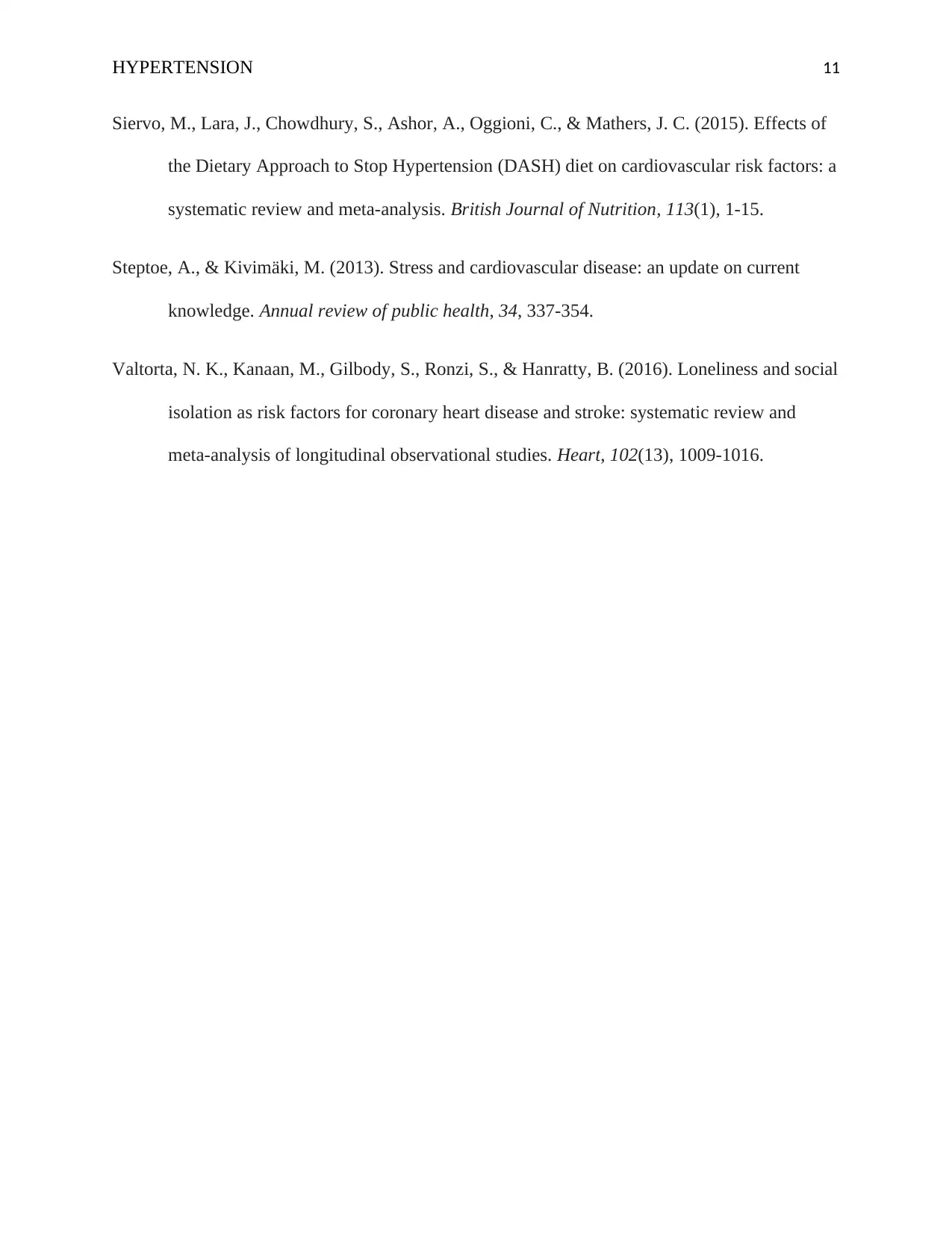
HYPERTENSION 11
Siervo, M., Lara, J., Chowdhury, S., Ashor, A., Oggioni, C., & Mathers, J. C. (2015). Effects of
the Dietary Approach to Stop Hypertension (DASH) diet on cardiovascular risk factors: a
systematic review and meta-analysis. British Journal of Nutrition, 113(1), 1-15.
Steptoe, A., & Kivimäki, M. (2013). Stress and cardiovascular disease: an update on current
knowledge. Annual review of public health, 34, 337-354.
Valtorta, N. K., Kanaan, M., Gilbody, S., Ronzi, S., & Hanratty, B. (2016). Loneliness and social
isolation as risk factors for coronary heart disease and stroke: systematic review and
meta-analysis of longitudinal observational studies. Heart, 102(13), 1009-1016.
Siervo, M., Lara, J., Chowdhury, S., Ashor, A., Oggioni, C., & Mathers, J. C. (2015). Effects of
the Dietary Approach to Stop Hypertension (DASH) diet on cardiovascular risk factors: a
systematic review and meta-analysis. British Journal of Nutrition, 113(1), 1-15.
Steptoe, A., & Kivimäki, M. (2013). Stress and cardiovascular disease: an update on current
knowledge. Annual review of public health, 34, 337-354.
Valtorta, N. K., Kanaan, M., Gilbody, S., Ronzi, S., & Hanratty, B. (2016). Loneliness and social
isolation as risk factors for coronary heart disease and stroke: systematic review and
meta-analysis of longitudinal observational studies. Heart, 102(13), 1009-1016.
1 out of 11
Related Documents
Your All-in-One AI-Powered Toolkit for Academic Success.
+13062052269
info@desklib.com
Available 24*7 on WhatsApp / Email
![[object Object]](/_next/static/media/star-bottom.7253800d.svg)
Unlock your academic potential
Copyright © 2020–2025 A2Z Services. All Rights Reserved. Developed and managed by ZUCOL.





